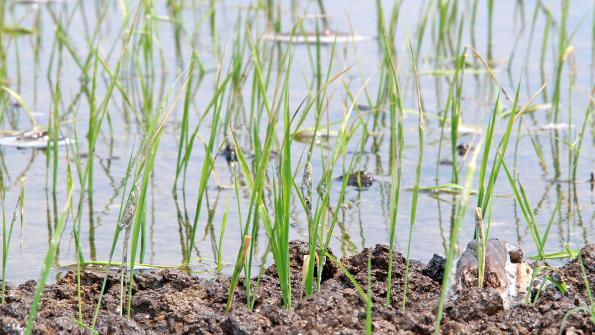May 28, 2015

For many Arkansas rice fields, options are running out for preflood nitrogen (N) applications. It’s time to play the hand we’re being dealt with no time to wait for new cards.
Last year we encountered similar problems, but no one was prepared to see a repeat of those prolonged wet and cool conditions. In some ways conditions may be worse this year than last.
Regardless, it’s back to the same drawing board as last year as we’re experiencing tremendous difficulty applying preflood nitrogen to rice the way we want — on dry ground at the 4- to 5-leaf stage before establishing the permanent flood.
In order of preference, based on yield response and N efficiency, here are options for applying preflood N based on field situations:
1. Field is dry: Apply NBPT-treated urea onto dry soil and establish the permanent flood in a timely manner to incorporate N below the soil surface. If you have any time to spare, it is always best to apply preflood N onto dry soil — applications onto muddy soil or into standing water are far less favorable and much less efficient methods of N fertilization.
2. Field is muddy: Apply NBPT-treated urea onto muddy soil and attempt to let the soil dry if you have time. If a significant rainfall event occurs (about 0.5 inch or more) to re-wet the field, then begin flooding. Otherwise let the soil dry before establishing the flood. In applying N to mud, we do not know how much N will be lost, but if you feel the need to increase the N rate, do so only slightly (10 to 20 pounds N higher). This increase may or may not provide much benefit, but it’s less likely to hurt in this case. Watch the crop closely and apply extra N if an N deficiency occurs.
3. Field has standing water: Get the water off the field if at all possible (if time allows). Many no longer have time to get the water off and let the soil dry. In this case, holding the water and “spoon-feeding” N into the flood in small quantities every five to seven days for three to four weeks is the best option — lean toward every five days. A small quantity means 45 pounds of N per acre (100 pounds of urea per acre). If you have a short time to internode elongation, maybe applying N for three weeks at 45, 60, and 60 pounds of N per acre will be better. However, smaller quantities applied more frequently are your best option in this situation. Do not, for any reason, apply the entire recommended preflood N rate in one application into standing water.
Worst case
Preferred “worst-case” management: Apply N to muddy/wet soil as rice reaches the end of the N application window according to the DD50 program. Attempt to let the soil dry out underneath the applied N and if a significant rainfall occurs, start flooding. Realize that some N is lost in this case and be prepared to monitor the crop closely and apply additional N later if the rice looks like it needs it.
Fields unable to hold a flood (levees and gates unfinished): Apply a small amount of N and wait for the soil to dry or receive upcoming rainfall. If heavy rain is expected and movement is a concern, ammonium sulfate should be used for this application; otherwise, apply NBPT-treated urea. If conditions are still not dry enough to flood the field in a week, subsequent N applications will be needed in the same manner until a flood can be established. At the point the flood can be established, apply any remaining N requirements to the dry soil and flood.
When preflood N is applied onto dry soil to rice at the 4- to 5-leaf stage and a flood is applied timely, plants take up at least 60 percent of the total N applied over the course of three weeks (10 percent in week 1; 20 percent in week 2; and 30 percent in week 3).
In general, the period from the optimum time to apply preflood N until internode elongation (IE) is about three weeks, but from the final recommended application time to IE is about two weeks. However, these timings are based on plant development when rice has received timely N fertilization and flooding — delaying these causes rice to develop more slowly. Keep in mind that we can only make up a small amount of yield with N applied at midseason.
Previous research has shown that N applied on dry soil has the most yield benefit. Applying urea onto muddy soil can result in a 20 percent yield loss. However, applying ammonium sulfate or urea + NBPT onto muddy soil and letting the soil dry can reduce the yield loss to only 10 percent. In this research, N was applied just prior to permanent flood at the 4- to 5-leaf stage.
Past the 4- to 5-leaf stage, potential yield losses could become more dramatic. However, many factors influence how much flexibility we have in our N fertilization timing, including cultivar, length of maturity, native soil N, soil type, etc. If native soil N is high, then the effect is reduced. If it is a longer season cultivar, then there is a greater window before midseason. In any case, don’t let it get too late before applying N.
Use of the DD50 Rice Management Program can help to time management decisions in these situations.
Hardke is Rice Extension Agronomist, University of Arkansas. [email protected]
You May Also Like




